![]() Today's Production Sound Mixer faces a choice: to record the production dialogue in single track (monaural), 2-track, 4-track, or even 8-12 track. In this article, based on Fred Ginsburg's popular live lectures during NAB 2010, the author presents a brief overview of multi-track recording for film and video production.
Today's Production Sound Mixer faces a choice: to record the production dialogue in single track (monaural), 2-track, 4-track, or even 8-12 track. In this article, based on Fred Ginsburg's popular live lectures during NAB 2010, the author presents a brief overview of multi-track recording for film and video production.
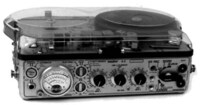 For most of Hollywood’s past, Production Sound was recorded live to just one track (monaural). The various location recorders (optical and magnetic) varied throughout the decades, and culminated with the legendary Nagra 4.2 sync recorder.
For most of Hollywood’s past, Production Sound was recorded live to just one track (monaural). The various location recorders (optical and magnetic) varied throughout the decades, and culminated with the legendary Nagra 4.2 sync recorder.
The craft of production sound recording consisted of mixing audio acquired by multiple mics (boom1, boom2, planted mics, and lavaliers) into one cohesive soundtrack (the production track). This live mixed soundtrack would serve as the audio for dailies, and then later for the picture editor’s versions.
After the editor declared that the picture cut was “locked”, the sound editors would begin to work their magic. The single soundtrack would first be split (checker boarded) onto multiple tracks so that each actor and sound effect could be treated individually (volume adjustments, EQ, etc.) Glitches such as pops, clicks, and other audibles would be removed. If the dialogue was deemed unusable, then ADR would be ordered. Ditto for sound effects and Foley.
Two Track as opposed to Stereo
It wasn’t until the early 1980’s that we began using two-track on location as the norm. True, there had been some early pioneering with 8 and 16 tracks by directors such as Altman. However, the monaural Nagra 4.2 was still the industry standard. But with the emergence and rapid industry acceptance of the new Nagra IV-STC stereo time code recorder, Hollywood entered the age of two track recording.
 Note that I use the term TWO TRACK, and not STEREO. It is important to make this distinction. On location, we do not generally think in terms of left and right (aka stereo) as one might in live music recording.
Note that I use the term TWO TRACK, and not STEREO. It is important to make this distinction. On location, we do not generally think in terms of left and right (aka stereo) as one might in live music recording.
The term stereo refers to capturing the left side and right side components of a sound, so that when they are reproduced out of a pair of left side and right side speakers, or headphones – the listener will have a sense of left and right balance or space. Sounds may originate on the left or right of the listener, and may even travel (“pan”) across from one side to the other, or just park somewhere in between hard left and hard right.
Stereo is what happens when we listen to music, or a fully mixed movie. It is the finished result for the enjoyment of the audience.
But stereo is rarely recorded as such in the field. Instead, we record monaural sounds and wait until post-production is nearly complete to re-assign these sounds to the audience’s left, right, and in-between.
 Until the film is edited, there is no way to know just where all of the audio elements need to end up. For instance, out on production, it might seem logical to record a car that passes from left to right in stereo, so that you can hear the “pass by” in your phones whoosh from the left ear to the right ear.
Until the film is edited, there is no way to know just where all of the audio elements need to end up. For instance, out on production, it might seem logical to record a car that passes from left to right in stereo, so that you can hear the “pass by” in your phones whoosh from the left ear to the right ear.
If the movie only consisted of that one angle of the car, with no intercuts, then your stereo track would be quite usable. However, in the real world, that car-by is likely to be covered from a multitude of camera angles, and then intercut with a multitude of close-ups and insert shots. Many (if not most) of this additional footage will represent screen center (as opposed to the wide shot of the car travelling from screen left to screen right).
As the finished sequence is built by the editor, it might start with a long shot of a car coming towards the screen, some left to right angles, maybe some more dead-on angles, some shots of the driver, inserts of gas pedals, shifter knobs, angles on the passenger, sheriff’s car lurking, woman with baby carriage about to cross the street, and…. You can see where this is going: it is certainly not a simple pan the sound from left to right situation. The editor would not want the audio to ping pong rapidly from screen left, to center, to left, to right, back to center, etc. The flow of the audio has to be paced with the changing perspectives of the shots; with full audio pans carefully and strategically employed for full effect, but not as meaningless distraction!
The solution is to record all of the sounds as monaural (center screen); and to let the editors re-mix and re-assign those sounds to various surround positions during post-production. Also, keep in mind that professional films are not two-track stereo presentations, but are at the least, surround sound six-track (aka 5.1 surround). Audio has to be positioned amongst screen left, screen center, screen right, surround rear left, surround rear right, and sub-woofer effect!
Therefore, if we are recording in two-track in the field, we do not think in terms of left track and right track. Instead, rename these connectors (in your head) as Track One and Track Two. You have two places to store the recorded audio; and the audio in these two places should be different, so that the editor has maximum flexibility to select/adjust one track over the other.
Microphones could be split across the two tracks so as to avoid phasing issues, such as when a boom mic might overlap a lavalier. Or, two lavaliers could be mixed to two different tracks in order to minimize noise, prevent phasing, and balance volume levels.
In some cases, track one could be a live mix, while track two serves as an iso of an important actor’s radio mic.
Four Track Comes of Age
 Fast forward almost a decade, and various formats of digital began to replace analog two track. First there was two track digital, and except for the difference in hardware, the mixing style was the same as it was back in the day of the Nagra two track analog tape recorders.
Fast forward almost a decade, and various formats of digital began to replace analog two track. First there was two track digital, and except for the difference in hardware, the mixing style was the same as it was back in the day of the Nagra two track analog tape recorders.
Two track digital soon evolved into four track digital, and a new style of mixing began to take hold.
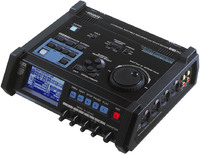 The sound mixer and editors had a choice. All of the production mics could be split amongst the four available tracks, similar to the way we used to mix to the two track. Only this time, there were four places to separate booms, plants, and lavaliers.
The sound mixer and editors had a choice. All of the production mics could be split amongst the four available tracks, similar to the way we used to mix to the two track. Only this time, there were four places to separate booms, plants, and lavaliers.
Although this seemed very efficient from a sound designer’s perspective, it did cause some problems when it came to dailies and picture edits. It was not always practical to re-mix the four tracks into something that would sound decent during basic playbacks. Merely combining all four tracks simultaneously would result in phasing issues, echo & dropouts, and horrible balance.
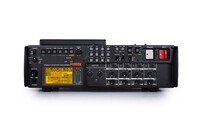 Instead, most soundmixers went back to the old school way of doing things. It was a return to mixing the way we did for the monaural soundtrack of the Nagra 4.2 -- a live production mix, able to stand on its own for dailies and picture edit.
Instead, most soundmixers went back to the old school way of doing things. It was a return to mixing the way we did for the monaural soundtrack of the Nagra 4.2 -- a live production mix, able to stand on its own for dailies and picture edit.
However, tracks 2 thru 4 were not wasted. Clean iso’s of key microphones, or groups of microphones, could be recorded clean for later use in post-production.
Physically, most mixing panels were easily capable of outputting four sub-mixes or direct outs from individual mics.
Today, there are two popular approaches to using a four track system. One popular techniques is to record a live mixdown onto one track, and to utilize the remaining tracks for ISO backup tracks of individual microphones, or groups of microphones (via a pre-fader Aux send).
The alternate approach is to record two monaural live mixdowns, along with only two ISO tracks. Although the content of each of the live mixdowns would be the same (aka dual mono), the second of the mono mixes would be recorded 10 to 15dB attenuated. In the event that an actor clips on the primary mixdown track, the editor would only need to bounce down to the alternate mix track in order to remedy the over modulation, and then return to the primary track for the other actors. This technique is very convenient and far less labor intensive than trying to completely reconstruct all of the audio dynamics in the scene by rebuilding a soundtrack from the ISO’s.
Multi-track Recorders on Modern Sets
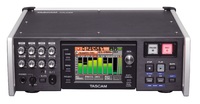 On todays feature films and episodic television, the use of 8-12 channel multi-track recorders have become standard operating procedure. Popular units include the Tascam HS-P82, Sound Devices 788T, and the Zaxcom Deva Fusion 10/12.
On todays feature films and episodic television, the use of 8-12 channel multi-track recorders have become standard operating procedure. Popular units include the Tascam HS-P82, Sound Devices 788T, and the Zaxcom Deva Fusion 10/12.
 The basic approach is to independently record each of your microphones onto its own channel, while simultaneously live mixing your mics to a composite or mixed down track. The mixdown version is used for immediate playbacks, dailies, and for the picture edit. After the picture cut is “locked”, the sound editors have the option of re-constructing all or part of the live production mix from the raw independent tracks (iso’s)
The basic approach is to independently record each of your microphones onto its own channel, while simultaneously live mixing your mics to a composite or mixed down track. The mixdown version is used for immediate playbacks, dailies, and for the picture edit. After the picture cut is “locked”, the sound editors have the option of re-constructing all or part of the live production mix from the raw independent tracks (iso’s)
As we have pointed out, sound mixers utilize a variety of microphone techniques for acquiring a full and realistic soundtrack. A typical feature film or TV show may use one or two boom mics simultaneously, along with some plant mics deployed around the set to get what the booms cannot, and a handful of radio mics on the key actors to cover action or as (iso) backup.
In the field, the sound mixer has the option of feeding the recorder from any suitable external mixing console, or utilizing a dedicated fader controller provided by the recorder manufacturer.
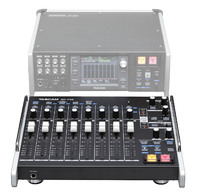 When the dedicated fader controller accessory is used, these recorders are able to record up to eight (or more) external inputs as iso’s, while simultaneously assigning and mixing down these channels to an additional pair of stereo tracks. The recording level for each input is initially set by use of the trim/gain pot, which determines the recording level onto each iso track. The levels of the mixdown stereo tracks are actively controlled by the faders (or pots), allowing the soundmixer to adjust mics during the take.
When the dedicated fader controller accessory is used, these recorders are able to record up to eight (or more) external inputs as iso’s, while simultaneously assigning and mixing down these channels to an additional pair of stereo tracks. The recording level for each input is initially set by use of the trim/gain pot, which determines the recording level onto each iso track. The levels of the mixdown stereo tracks are actively controlled by the faders (or pots), allowing the soundmixer to adjust mics during the take.
Example: Inputs/tracks 1-8 represent boom, plant, and radio mics. They are mixed down to tracks 8-9.
Sometimes, the use of a more sophisticated mixing console is preferred. External mixing boards (such as the Presonus 16.4.2) offer a greater number of microphone inputs, subs, monitor outs, boom outs, better signal processing (EQ, compression, gates, limiters, etc.) and digital recall. The downside of using a non-dedicated mixing panel is that the soundmixer sometimes (depending on the particular model of multi-track recorder) can no longer avail himself of being able to record all of the inputs as iso’s and mix them down to a stereo pair. (Some recorders are not friendly when it comes to fluidly accessing and controlling the levels to their internal mixdown tracks.)
Instead, the soundmixer will simply dedicate one of the recorder inputs to receive the mixdown from the panel; and utilize the remaining recorder inputs for iso’s.
Example: Recorder Input/track 1 is fed from the main output of the board. Recorder input/tracks 2-7 could be iso’s (boom, radio mics), and are sent from the Direct Outs of the mixer. Any misc plant mics or radio mics could be assigned to one or two of the mixer Sub or Aux Outputs, and that Aux Output(s) could be sent to input/track 8 (or tracks 7 & 8) of the recorder.
In this way, a complex show involving a large number of microphones could be mixed down to 8 or 10 tracks. Not every microphone needs to have its own iso track. An aggregate of minor characters could be combined to one Aux track; or any actors whose lines do not overlap in the timeline (i.e. do not appear in the scene at the same time) might easily share a single iso track.
Reality TV
Sometimes, a sound mixer is just a recordist. A growing trend amongst so-called reality television shows is to just record everything that moves, and then just let the editors deal with it.
On set, the soundperson is responsible for recording the iso tracks, consisting of a number of radio mics and maybe a boom mic for ambiance or misc audio. The mixdown is not important at this stage, since it is being shot documentary style, and most likely with multiple cameras. Until a story is carved out of this footage by the editors, a soundperson would have no way of knowing which mics to open and close or what perspective to mix for, so very little priority is given to achieving a live mixdown.
In most cases, it is a matter of set ‘em and forget ‘em. Get clean audio on all of your tracks, and don’t worry about the mix. To give credit where credit is due, wrangling all of those wireless and a boom – in an unscripted environment full of the unexpected – is a skill all of its own, and one that is far from easy.
Choose what works for you
In this article we have examined a few different approaches to the use of multi-track recording for film and video production.
You no longer have to decide between having a balanced, live mix production soundtrack for dailies and editing, complete with the occasional human error of a missed cue – or a set of virgin iso tracks, devoid of any fader activity, that can later be reconstructed into the perfect soundtrack.
The benefit of multi-track is that it allows you to “have your cake and eat it too”.
